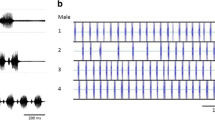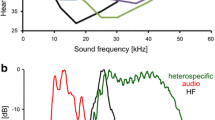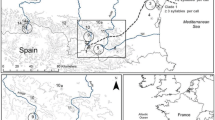Abstract
Synchronising bushcricket males achieve synchrony by delaying their chirps in response to calling neighbours. In multi-male choruses, males that delay chirps in response to all their neighbours would remain silent most of the time and be unable to attract mates. This problem could be overcome if the afferent auditory system exhibited selective attention, and thus a male interacted only with a subset of neighbours. We investigated whether individuals of the bushcricket genus Mecopoda restricted their attention to louder chirps neurophysiologically, behaviourally and through spacing. We found that louder leading chirps were preferentially represented in the omega neuron but the representation of softer following chirps was not completely abolished. Following chirps that were 20 dB louder than leading chirps were better represented than leading chirps. During acoustic interactions, males synchronised with leading chirps even when the following chirps were 20 dB louder. Males did not restrict their attention to louder chirps during interactions but were affected by all chirps above a particular threshold. In the field, we found that males on average had only one or two neighbours whose calls were above this threshold. Selective attention is thus achieved in this bushcricket through spacing rather than neurophysiological filtering of softer signals.




Similar content being viewed by others
References
Alexander RD (1967) Acoustical communication in Arthropods. Annu Rev Entomol 12:495–526
Bailey WJ, Greenfield MD, Shelley TE (1993) Transmission and perception of acoustic signals in the desert clicker, Ligurotettix coquilletti (Orthoptera: Acrididae). J Insect Behav 6:141–154
Batschelet E (1981) Circular statistics in biology. Academic, New York
Brenowitz EA (1989) Neighbour call amplitude influences aggressive behaviour and intermale spacing in choruses of the Pacific treefrog (Hyla regilla). Ethology 83:69–79
Brenowitz EA, Wilczynski W, Zakon HH (1984) Acoustic communication in spring peepers. Environmental and behavioural aspects. J Comp Physiol 155:585–592
Fertschai I, Stradner J, Römer H (2007) Neuroethology of female preference in the synchronously singing bushcricket Mecopoda elongata (Tettigoniidae; Orthoptera): why do followers call at all? J Exp Biol 210:465–476
Frank H, Althoen SC (1994) Statistics concepts and applications. Cambridge University Press, Cambridge
Gerhardt HC, Diekamp B, Ptacek M (1989) Inter-male spacing in choruses of the spring peeper, Pseudacris (Hyla) crucifer. Anim Behav 38:1012–1024
Greenfield MD (1994) Cooperation and conflict in the evolution of signal interactions. Annu Rev Ecol Syst 25:97–126
Greenfield MD, Roizen I (1993) Katydid synchronous chorusing is an evolutionarily stable outcome of female choice. Nature 364:618–620
Greenfield MD, Snedden WA (2003) Selective attention and the spatio-temporal structure of orthopteran choruses. Behaviour 140:1–26
Greenfield MD, Tourtellot MK, Snedden WA (1997) Precedence effects and the evolution of chorusing. Proc R Soc Lond B 264:1355–1361
Hartbauer M, Kratzer S, Steiner K, Römer H (2005) Mechanisms for synchrony and alternation in song interactions of the bushcricket Mecopoda elongata (Tettigonidae: Orthoptera). J Comp Physiol A 191:175–188
Minckley RL, Greenfield MD, Tourtellot MK (1995) Chorus structure in tarbush grasshoppers: inhibition, selective phonoresponse and signal competition. Anim Behav 50:579–594
Nityananda V, Balakrishnan R (2006) A diversity of songs among morphologically indistinguishable katydids of the genus Mecopoda (Orthoptera: Tettigonidae) from southern India. Bioacoustics 15:223–250
Nityananda V, Balakrishnan R (2007) Synchrony during acoustic interactions in the bushcricket Mecopoda ‘Chirper’ (Tettigoniidae:Orthoptera) is generated by a combination of chirp-by-chirp resetting and change in intrinsic chirp rate. J Comp Physiol A 193:51–65
Pollack GS (1988) Selective attention in an insect auditory neuron. J Neurosci 8:2635–2639
Römer H (1998) The sensory ecology of acoustic communication in insects. In: Hoy RR, Popper AN, Fay RR (eds) Comparative hearing: insects. Springer, Berlin, pp 63–96
Römer H, Bailey WJ (1986) Insect hearing in the field. II. Male spacing behaviour and correlated acoustic cues in the bushcricket Mygalopsis markii. J Comp Physiol A 159:627–638
Römer H, Krusch M (2000) A gain-control mechanism for processing of chorus sounds in the afferent auditory pathway of the bushcricket Tettigonia viridissima (Orthoptera; Tettigoniidae). J Comp Physiol A 186:181–191
Römer H, Lewald J (1992) High-frequency sound transmission in natural habitats: implications for the evolution of insect acoustic communication. Behav Ecol Sociobiol 29:437–444
Römer H, Marquart V, Hardt M (1988) Organization of a sensory neuropile in the auditory pathway of two groups of orthoptera. J Comp Neurol 275:201–215
Römer H, Hedwig B, Ott SR (2002) Contralateral inhibition as a sensory bias: the neural basis for a female preference in a synchronously calling bushcricket, Mecopoda elongata. Eur J Neurosci 15:1655–1662
Snedden A, Greenfield MD, Jang Y (1998) Mechanisms of selective attention in grasshopper choruses: who listens to whom? Behav Ecol Sociobiol 43:59–66
Acknowledgments
We thank the Ministry of Environment and Forests, Government of India, for funding part of this project. We are grateful to Prof. Sumantra Chattarji for use of the software for spike analysis. The experiments comply with the legal principles of animal care and animal welfare of the Government of India. The project was supported by the Austrian Science foundation (FWF), project P17540-B06 to H.R.
Author information
Authors and Affiliations
Corresponding author
Rights and permissions
About this article
Cite this article
Nityananda, V., Stradner, J., Balakrishnan, R. et al. Selective attention in a synchronising bushcricket: physiology, behaviour and ecology. J Comp Physiol A 193, 983–991 (2007). https://doi.org/10.1007/s00359-007-0251-9
Received:
Revised:
Accepted:
Published:
Issue Date:
DOI: https://doi.org/10.1007/s00359-007-0251-9




